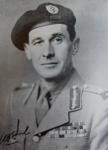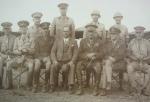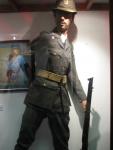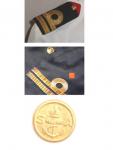-
Posts
133 -
Joined
-
Last visited
Content Type
Profiles
Forums
Blogs
Gallery
Events
Store
Everything posted by milhistry
-
Thanks everyone! Mysteries solved! I was not aware that he was a KStJ as well. I've found a reference to him being made a Commander of the Legion of Merit at the victory pde in Monza. I assume the bar on the ribbon in the top photograph is the device shown here: http://en.wikipedia.org/wiki/Legion_of_Merit
-
Arthur R - Many thanks for the speedy and detailed response. You have confirmed, clarrified & added to some of the information I had. The pictures are excellent! I'll attempt to add pictures of the few items I have. From the above it would seem to be mostly pre 1986 other ranks badges and titles. My cloth flashes are scarlet on khaki. I have also seen gold on green ones but am not sure whether they are genuine issue or not (I know most infantry units had gold on green flashes on the bunny jacket in the 1960s). I also have a WW2 cap badge and a shoulder title that I think says "2/Dukes". Was there a 2nd Bn at some point? From the photographs you linked to: It's interesting to note that the officers rank stars now have a protea in the centre. Also of interest is that the red tabs on the shoulders appear to be about 38 mm wide. This is probably to accomodate the curved title adequately. Most wartime red tabs I've come across ahve been 25 mm. Mervyn - Indeed. Much of the SA Traditional Regiments traditions and distinctions are not well publicised. Especially the last few decades worth of changes to dress distinctions. While some regimental histories published in the 60s & 70s gave some information not much has been written since. A few years ago I wrote to virtually every tradtional regiment in SA asking for information, with the aim of writing articles on their dress distinctions, largely to no avail. I think NMR were the most useful (mainly due to some militaria enthausiasts/collectors serving in it at the time). I'd be happy to start of a few discussions of other regiments as well (if nobody else does) and see what comes out of the woodwork. I'll add some Duke related pictures soon and hopefully others do the same.
-
I'm always after information about dress distinctions of the South African traditional regiments. While living in Natal I gathered a fair bit of information on Natal regiments but I'd like to add to what I have on regiments from my home province of the Cape. I only have a handful of Dukes badges & would be very interested in getting more information & preferably some photographs of their dress distinctions.
-
Yes, indeed. My relative who was in the PF during this period was attested by Pienaar, nearly got transferred to van Ryneveld and later worked for Brink. Thanks for the comments. Always good to get additional info. I've found an interetsing picture of the khaki drill uniform. It's from "Camera in my kitbag" and shows SA troops at Buckingham Palace in 1937.
-

Pre -1994 South African Police Uniform
milhistry replied to ocpd71's topic in Police Forces of the World
I have a spare lead grey SAP safari suit somewhere (it is still sealed in a plastic bag). I have been trying to piece together information and photos of the earlier SA Police uniforms (i.e. pre 1961) over the past few years. I have extracts from old dress regs etc. but a picture is always worth more. If anyone has nice examples of the older uniforms to post that would be great. -

Current South African Police Dress Uniforms
milhistry replied to Mervyn Mitton's topic in Police Forces of the World
There are two subtle differences from the pre-94 era uniform. The current dress cap has a darker blue crown (as opposed to the previous almost lead-grey shade). The "tunics" (I am not sure of the current official designation for these jackets in the SAPS) now have two breast pockets instead of four and the waistbelt is no longer worn. -
A picture of various senior officers taken sometime in the 1930s. Note the variety of dress. This picture is included to illustrate some of the other uniforms mentioned. e.g. Colonels Dan Pienaar & George Brink (seated L & R ends respectively) are both wearing shirt sleeves. Pienaar with putties and Brink with canvas leggings. Colonel Frank Theron is wearing light khaki gaberdine with shorts and canvas leggings. Brig-Gen Wakefield appears to be wearing the green-brown barathea jacket with khaki shorts and leather leggings. Maj-Gen Andries Brink is wearing breeches with field boots. Brig-Gen van Ryneveld... hard to tell whether breeches or plus fours but they seem to be much lighter in colour than AJ Brink's. Colonels Naude' and de Waal (back row) are wearing light khaki gaberdine. The two unknown standing officers are wearing the polo pattern helmet which puts this photo after 1934. I'll see if I can find a nice picture of the other rank's khaki drill uniform.
-
Thanks! That certainly fills a lot of gaps in my info. I'm trying to work out what a relative of mine would have worn when in the PF and that gives me a much better picture. I've managed to find a few, fairly poor, photos of the grey-green uniform that I'll attempt to post a few here for interest. The first (SAAF one with helmet) shows the step collar (I took this photo in the SAAF Museum several years ago). I assume this is the 5 button step collar type? The 5th button must be hidden under the webbing belt. (If this is the case, the polo helmet would be out of place however as they didn't come onto the scene until the 1930s).
-
Thanks for that. I've seen references to "veld green" and "veld grey" and was wondering whether these were the same uniform or not. I've seen a grey-green uniform (simmilar colour to the service dress worn by SWATF in the 1980s) which as far as I can determine was worn, in South Africa at least, up to WWII. I've also seen pictures of the SSB other ranks wearing khaki drill, step-collared jackets in the mid to late 'thirties (with polo pattern helmets), which would be the summer dress you describe above. What I would really like to establish is when the drab (i.e. greenish-brown) service dress replaced the green-grey version (or were they worn concurrently)? The drab, barathea service dress seems to have been almost universal during WW2 (along with the light khaki gaberdine version). I've seen numerous photographs (including ones of my grandfather) wearing the greenish-brown barathea SD jacket with khaki shorts and long stockings (possibly hose-tops) during WW2 which supports de Villiers' suggestion, except that (in my grandfathers case at least) it was the green-brown jacket not the grey-green one. I had not until now made the connection between the wearing of drab jackets with KD shorts to the two-tone Whipcord uniform introduced in the 1950s. I had assumed that the inspiration was the US Army Class A "pinks" uniform worn by US oficers in Korea as the changeover to the two-tone uniform in South Africa coincided with the Korean conflict. My interest in the grey-green uniform is two-fold. (1) I am trying to establish what uniform would have worn when serving in the Permanent Force from 1922-1939 (2) it was, as far as I'm aware, the second attempt at creating a uniquely South African service dress uniform (the first being the short-lived Active Citizen Force uniform of 1913-14).
-
For the South African late-1980s version. Theoretically there should be one for each territorial Command plus one for the Provost School (which had a gordian knot on the sword instead of the enamel device). Commands were: 1. Western Cape 2. Southern Cape (absorbed into Western in late 1980s I think, so may not have had one) 3. Eastern Cape and Border 4. Natal 5. Free State 6. North West 7. Northern Transvaal 8. Far North 9. Northern Cape. The Territory of South-West Africa had their own MP badges (anothe rone for you to collect!). You also need the two patterns of beret bar worn under the badges from late 1980s.
-
Beyers went on to become Commandant-General of the Active Citizen Force in 1913 (before resigning his commission and attempting to join the rebellion - he drowned en route). Most sources list him as the first & only person to be Commandant-General of the ACF but I have seen a (presumable hastily typed!) Minute in the SA Archives dated 1914 appointing one Major-General J C Smuts as Commandant-General of the Citizen Force and Commandoes with immediate effect. Something that is usually neglected a mention in Smuts' biographies. One positive note about Beyers, he did forsee the importance of air power fairly early on and some credit due to him for the creation of the SA Aviation Corps in 1913. The double sized medal is a clever economic measure. Interesting too that although an official South African Award it did not carry the South African coat-of-arms but that of both defunct republics. The Dekoratie voor Trouwe Dienst (= decoration for faithful service) is also an interesting creature - worthy of it's own posting. It was issued for similar reasons as a British DSO. In the Union's order of precedence it also outranked a DSO. A small number of Boer Officers went on to get the DSO in WW1 and were subsequently awarded the DTD for service in the Boer War.
-

Sailor Malan's medals
milhistry replied to milhistry's topic in Great Britain: Orders, Gallantry, Campaign Medals
Thanks for that. I'll contact them and see what happens. -
There was also a highly publicised theft of several Victoria Crosses from the same museum a few years ago. One has to wonder how national treasures could be stored with such poor security. Fortunately many of the medals were recovered. One only hopes that security has been improved. I have been to the museum a few times and it's certainly worth a visit however I think I shan't be loaning any of my collection to it given its recent track record. Personally I think the curators and higher-up should have been held to account as well (at least to some extent) Afterall, if a lowly soldier misplaces an item of kit, they get charged.... apparently the same rules don't apply to the field officers who are in charge of the museum nor the beauracrats who control the budgets.
-
I have a uniform to an officer of the 14/20th KH in light khaki (equivalent of No. 4 Dress). I would like to obtain the correct headdress and acoutrements to go with it. Does anyone have Dress Regs. or photos of this type of uniform being worn? What headdress would be appropriate? Coloured f/s cap, No 1 Forage cap, SD Caps, beret? Any help appreciated. Thanks.
-
Correct.Originally it indicated that they had signed the "Africa Service" oath (to serve anywhere in Africa) & later the "General Service" oath (to serve "anywhere"). It was worn by anyone who had thus volunteered regardless of whether they actually ended up serving outside the Union or not. Thanks for removing my previous blunders. Good to know who to contact in future.
-

BRITISH CUSTOMS BADGE
milhistry replied to Mervyn Mitton's topic in Great Britain: Militaria: Badges, Uniforms & Equipment
I think the gilt badge above was worn by Rhodesian Customs before UDI. HM C&E "preventative officers" wore an embroidered badge consisting of a portcullis surrounded by a wreath and surmounted by a crown. A very nice badge actually. South Afircan Customs incidently had a similar badge but with a protea flower instead of a crown. Early in the 20th century UK Customs wore crowns and crowns inside wreaths (similar in appearance to a WO II RQMS rank badges) depending on the rank/grade -
Does anyone know ther whereabouts of Group Captain A G "Sailor" Malan, DSO and bar, DFC and bar, etc.'s medal group? I would like to obtain a photograph of the group and/or ribbon bar. The RAF museum does not have it and I assume the authorities in South Africa at the time of his death would not have been interested in it given the disrespectful way in which he & many other ex-servicemen were treated by the government of the day.








